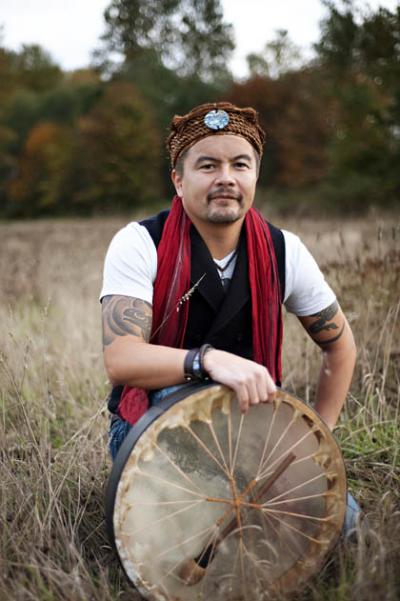
Coast Salish Art Discussed by Noted Artist Shaun Peterson

In these late summer days two hundred years ago, the people of Vashon were occupied with harvesting horse clams, fish, and the berries of salal and huckleberry bushes. They were smoking and drying many of them for winter, because they had no grocery stores or coffee shops to visit during the cold January drizzle. They would spend winter sheltering in big cedar longhouses, cooking stews in watertight baskets and telling stories about the salmon people and the Changer, whose gifts kept them fed and comfortable year around.
Out of their culture of stories and gifts emerged the designs of the south Coast Salish people, an artistic tradition still being created anew by their descendants. To explain how their culture and art have responded to change, the gifted contemporary artist Shaun Peterson will give a presentation at the Land Trust Building on Saturday afternoon, September 13, at 3:00pm. The Land Trust is across the street (moreorless) from the Vashon Heritage Museum where Peterson’s sculpture of the Devilfish (octopus) highlights a special exhibit exploring the history of the sxwobabc people of Vashon, a Salish group who are part of the Puyallup Tribe. The museum will be open from 1:00pm to 5:00pm during the afternoon. Both talk and museum are free to all.
Shaun Peterson, born in 1975 and mentored by his grandparents who lived next door, learned young about his people’s traditions. In a 2005 ceremony he received the name Qwalsius, meaning “painted face” or “travelling to the face of enlightenment,” which had been the native name of his great grandfather Lawrence Williams. He honors his family and his ancestors in his approach to his art. His work has drawn the attention of numerous museums, art galleries, universities, and public works commissions because of his skillful merging of modern and traditional materials with ancient themes and design elements from his Puyallup and Tulalip heritage.
His largest piece, a red cedar welcome figure 24 feet high standing in Tacoma’s Tollefson Square, is strengthened inside with steel, a new method he developed in consultation with engineers, shipwrights, and seasoned sculptors. This figure of a Salish woman holds out her open hands to welcome people to the square, which is also the site of an ancient Puyallup village. The gesture of hospitality is a fitting representation of the Puyallup people: as their website states, “the name S’Puyalupubsh means generous and welcoming behavior to all people…who enter our lands.”
One of Shaun Peterson’s mentors, Makah artist Greg Colfax, helped get the welcome figure started. Peterson’s many other teachers include Steve Brown, Loren White, and George David (Nuu-chah-nulth). Using cedar, paper, glass, aluminum, steel and other materials, he has developed proficiency with tools as varied as adzes, chisels, knives, pens, water jets, computer graphics programs, digital inkjet, and laser cutters. His creations have become part of public collections around the world, from Germany and Ireland to Japan and China.
In 2013 the Greater Tacoma Community Foundation named him the winner of their annual Foundation of Art Award. Foundation President and CEO Rose Hamilton noted that, “He provides a bridge between the past and the future,” and is “as skilled in traditional design and technique as he is in the latest new media.” Peterson himself has said, “I believe that the art itself has been most responsible for preserving our stories through intrigue and curiosity. Though I work in a variety of media, I keep in mind that it’s not the media that drives the works themselves, but the story or feelings that they are supposed to carry to the observer.”
Those stories and feelings, because they reflect the unique culture from which they spring, are different in design and content to reflect the differences between tribes and periods of origin. This forms the subject of Shaun Peterson’s September 13 presentation, “The Coast Salish: Adaptations to the Present,” which will draw comparisons between the art of the far northern tribes such as the Tlingit and Haida, versus the southern Coast Salish of Puget Sound. He will describe their underlying cultural differences and give an overview of some of the dozens of tribal groups that once spanned hundreds of miles of British Columbia and Washington coast. The Puyallup Tribe itself, he notes, included three somewhat specialized geographic groups in pre-contact times: the inland people, the river people, and the island people. . For more information about Peterson, visit his website: www.qwalsius.com
The Vashon-Maury Island Heritage Association is grateful to 4Culture for a grant that enabled them to commission the Devilfish sculpture from Shaun Peterson. The Heritage Association also wishes to thank Humanities Washington for their financial support of Peterson’s presentation. A related program sponsored by Humanities Washington in November will feature a film about the fishing rights struggles of the ‘60s and ‘70s, followed by a discussion with several Puyallup people who participated in the protests. Sponsors of the museum’s special exhibit about the sxwobabc include Puget Sound Energy, Dig, Beth de Groen, Rick’s Diagnostic & Repair Service, The Hardware Store, John L. Scott Real Estate, Northwest School of Animal Massage, and Vashon-Maury Island Heritage Association.
- Login to post comments
